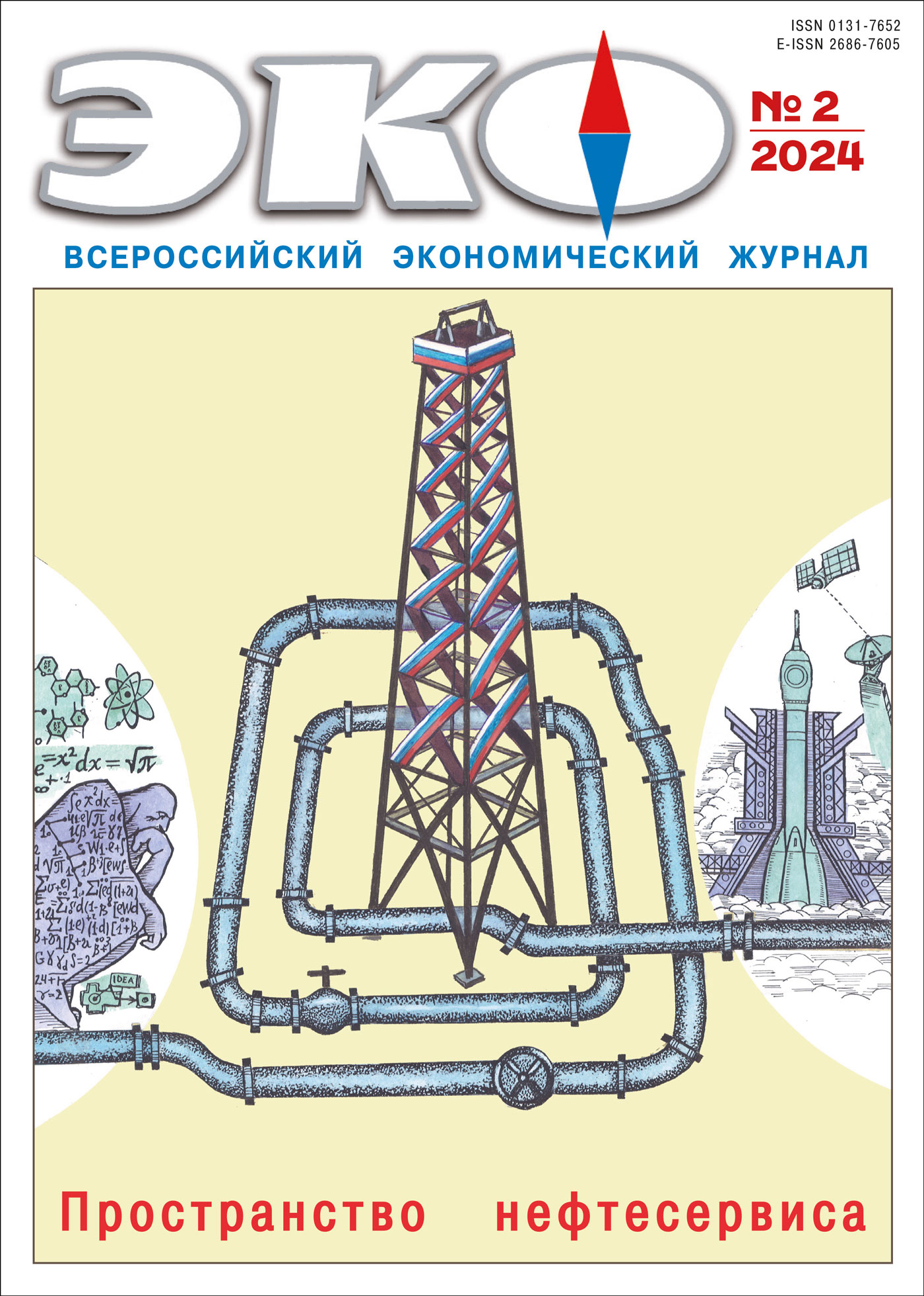Cover story: Oilfield Service Space
Published 2024-04-08
Keywords
- oil and gas field service; innovation; socio-economic development; taxes; resource region; knowledge
How to Cite
1.
Kryukov В, Tokarev А. Oil and Gas Field Service: from Global Context to Local Knowledge and Effects. ECO [Internet]. 2024 Apr. 8 [cited 2026 Jan. 18];54(2):8-28. Available from: https://ecotrends.ru/index.php/eco/article/view/4718
Abstract
The article analyzes the features of oil and gas service development in the global and Russian context. It shows the innovative role of service in the production of hydrocarbon raw materials, its importance in the development of the industry and the formation of socio-economic effects. The authors argue that the models of innovative development in oil and gas regions can be successfully developed on the basis of embedding oil and gas related services in them with consideration of a wide range of local peculiarities. The estimates indicated that oil and gas services play an important role in terms of budget tax revenues and employment in oil and gas regions. The obtained results prove the necessity of strengthening the role of resource regions in the regulation of oil and gas service and innovation processes.References
- Касаткин Д., Накорякова Л. Обзор рынка upstream и нефтесервиса – 2022. Аналитический центр Kasatkin Consulting, 2022. 18 с.
- Крюков В.А., Токарев А.Н. Локализация эффектов от развития нефтегазового комплекса как источник роста экономики Томской области // Томская область: трудный выбор своего пути. Новосибирск: ИЭОПП, 2014. С. 111–152.
- Лебедев Д. REnergyCO: Нефтесервисный рынок России в глобальном контексте // ROGTEC (Российские нефтегазовые технологии). 2022. № 68. С. 8–18.
- Шафраник, Ю.К., Крюков, В.А. Нефтегазовый сектор России: трудный путь к многообразию. М. и др.: Издательство «Перо». 2016. 270 с.
- Andersen, А., Mann, А., Simensen, Е. (2018). Innovation in natural resource-based industries: a pathway to development? Introduction to special issue. Innovation and Development. Vol. 8 (1). Pp. 1–27. DOI: 10.1080/2157930X.2018.1439293
- Asheim, B., Isaksen, A. (2002). Regional Innovation Systems: The Integration of Local ‘Sticky’ and Global ‘Ubiquitous’ Knowledge. The Journal of Technology Transfer. Vol. 27. Issue 1. Рp. 77–86. DOI: 10.1023/A:1013100704794
- Asheim, B., Isaksen, A. (1996). Location agglomeration and innovation: Towards regional innovation systems in Norway? – STEP group. Report 13–96. Oslo. 64 p.
- Audrectsch, D., Feldman, M. (2003). Knowledge Spillovers and the Geography of Innovation. Vol. 4. 45 p.
- Boshma, R. (2005). Proximity and Innovation: A Critical Assessment. Regional Studies. Vol. 39. Issue. 1. Pp. 61–74. DOI: 10.1080/0034340052000320887
- Ellison, G., Edward, L. (1999). The geographic concentration of industry: Does natural advantage explain agglomeration? Quarterly Journal of Economics. Vol. 35 (4). Pp. 311–316.
- Figueiredo, P.N., Piana, J. (2021). Technological learning strategies and technology upgrading intensity in the mining industry: evidence from Brazil. The Journal of Technology Transfer. Vol. 46. Pp. 629–659. DOI: 10.1007/s10961–020–09810–9
- Hu, J. (2014). Geographical Space Distribution of China’s Oil and Gas Industry: Characteristics and Drivers. Journal of Resources and Ecology. Vol. 5. Issue 1. Рp. 68–73.
- Isaksen, A., Karlsen, J. (2012). What is regional in regional clusters? The case of the globally oriented oil and gas cluster in Agder, Norway. Industry and Innovation. Vol. 19 (3). Pp. 249–263. DOI: 10.1080/13662716.2012.669616
- Kryukov, V., Tokarev, A. (2022а). Spatial trends of innovation in the Russian oil and gas sector: What does patent activity in Siberia and the Arctic reflect? Regional Science Policy and Practice. Vol.14. Issue 1. Pp. 127–146. DOI: 10.1111/rsp3.12445
- Kryukov, V.A., Tokarev, A.N. (2022b). The Oil Industry in the South of Tyumen Oblast: Enclaves or Clusters? Regional Research of Russia. Vol. 12. No. 2. Pp. 113–123. DOI: 10.1134/S2079970522020150
- Kryukov, V., Tokarev, A. (2023). Hard-to-recover oil reserves in the context of sustainable development of resource regions. E3S Web of Conferences. IVth International Conference “Energy Systems Research” (ESR-2023). Irkutsk, Russia. September 11–15. / eds. V. Stennikov, S. Senderov, A. Vichalevech, N.A. Yusifbayki. Vol. 470. Art. No. 01026. DOI: 10.1051/e3sconf/202347001026
- Lundvall, B.-A. (2004). The economics of knowledge and learning. Product Innovation, Interactive Learning and Economic Performance (Research on Technological Innovation, Management and Policy, Vol. 8). Christensen J., Lundvall B.-A. (ed.). Emerald Group Publishing Limited. Pp. 21–42.
- Moulaert, F., Sekia, F. (2003). Territorial Innovation Models: A Critical Survey. Regional Studies. Vol. 37. Issue. 3. Pp. 289–302. DOI: http://dx.doi.org/10.1080/0034340032000065442
- Perrons, R. (2014). How innovation and R&D happen in the upstream oil & gas industry: Insights from a global survey. Journal of Petroleum Science and Engineering. Vol. 124. Pp. 301–312. DOI: http://dx.doi.org/10.1016/j.petrol.2014.09.027
- Sasson, A., Blomgren, A. (2011). Knowledge Based Oil and Gas Industry. Research Report. No. 3. BI Norwegian Business School. Department of Strategy and Logistics. 131 p.
- Shearmur, R. (2010).Space, place and innovation: a distance-based approach. The Canadian Geographer. Vol. 54. Issue 1. Pp. 46–67. DOI: 10.1111/j.1541–0064.2009.00302.x
- Sukkoo, K. (1999). Regions, resources, and economic geography: Sources of U.S. regional comparative ad-vantage, 1880–1987. Regional Science and Urban Economics. Vol. 29 (1). Pp. 1–32.

